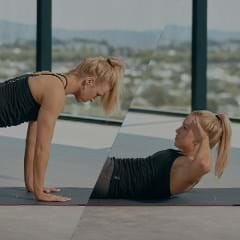You’ve developed, tested and proven something called the One Minute Workout – and recently published a book showcasing the formula and the research behind it. Are we really talking about a workout lasting for just 60 seconds?
Specifically the One Minute Workout is three 20 second bursts of very hard exercise. It is typically set within a ten minute time commitment, so there’s a little bit of a warm up, there’s a cooldown and there’s some recovery within those intervals of work.
So allowing 10 minutes of exercise, three times a week is all the exercise you need?
Well… that depends. People exercise for lots of different reasons. What’s interesting is that we now have good evidence that intervals can be a time-efficient way to generate a lot of the fitness benefits that we usually associate with a more traditional continuous moderate approach.
When we’ve tested the One Minute Workout protocol against the traditional exercise guidelines we’ve shown that after several months the improvement in cardiorespiratory fitness on average is the same. The improvement in health related indices like insulin sensitivity is the same, and even changes in physiological markers, such as mitochondrial content and cellular changes in the muscles, on average, are the same.
It shows that you can elicit adaptations that are very similar to traditional endurance exercise in less time with an interval-based approach. That’s not to say this is the only way to train, or that people should only do a few minutes of exercise a week, or that it’s going to elicit all of the adaptations that we associate with the traditional approach.
Tell us about what it takes to make these 20 seconds of intense exercise effective? How intense does that need to be to make those 20 seconds so valuable?
There is no free lunch. So if you’re wanting the benefits of short burst exercise you need to go hard. In our studies people cycled as hard as they could for 20 seconds, you could equate that to running up hill as hard as you can for 20 seconds. We’re talking about all-out efforts. The interesting thing is though, because the efforts are relatively short and followed by a period of recovery, they’re not perceived as all-out maximal.
“There is no free lunch … If you are wanting the benefits of short burst exercise you need to go hard. We’re talking about all-out efforts.”
Is the One Minute Workout just a way to get new people into exercise, or should we all switch longer workouts for the shorter, more intense variety?
I think it really depends on the individual, and I think there’s little value in trying to pitch it as one or the other. Intermittent vigorous exercise is really just another choice on the exercise menu. So on those days when you’re time-pressed and you might otherwise blow off a workout because you only have ten minutes, intervals can be a really good choice that can help maintain, and ideally boost your fitness.
You talk about there being lots of different menu choices, what’s the ideal weekly consumption for a regular exerciser? What do you do in a week?
I am an exercise physiologist, so I am highly motivated to exercise and would easily meet the 150 minutes a week guidelines. But typically most days I don’t train for any more than 30 minutes. My own workouts tend to be either interval based indoor cycling in the winter or trail or mountain bike rides in the summer. Then, every other day I do some sort of bodyweight style interval training, you know push-ups, pull ups, that sort of thing, sometimes light cleans, light bench press. I tend to vary it up.
Some believe that it is unwise to do HIIT workouts more than a couple of times a week …
It really depends on the specific type of HIIT workouts you’re engaged in. I am someone who trains almost exclusively using intervals, but it’s not like all of the intervals are all-out as hard as you can go. Interval training comes in so many flavors that HIIT workouts can range tremendously. You can do an interval workout simply walking around the block, picking up the pace and then backing off. At the other end of the scale you have the most extreme interval training, you know all-out hard workouts that last much longer than the one minute workout. However, it is extremely mentally and physically demanding to do very high intensity, high volume interval workouts all the time.
So are there risks? And how can they be avoided?
We shouldn’t overstate the potential risk of interval training. Let’s remember, the greater health risk is remaining sedentary and staying on the couch!
In fact, there is a large and growing body of research that shows that interval training has been effectively applied to mitigate risk in people with cardiovascular disease, people with diabetes, people with metabolic syndrome, older individuals… It all comes down to properly tailoring the training to an individual, maybe starting with interval walking and then progressing from there.
So when you talk about specific types of HIIT workouts, are there exercises that work better than others?
Again, I think it depends on the individual – the best exercise is something you like because you’re more likely to stick with it. Generally speaking, a well-rounded approach is always going to be best. It’s important to be doing some cardiovascular training along with muscle strengthening to maintain functional strength and movement capacity. And if you can, get in some flexibility, perhaps yoga or Pilates. That being said, if you’re someone who just likes to do interval cycling then it’s certainly better than just doing absolutely nothing – although I would encourage the periodic inclusion of functional style bodyweight training to round out your fitness program.
What are the safest interval options?
The potential for injury is higher with more intense, impactful exercise. So if you’re running, whether on hills, stairs or the flat, when you pick up the intensity the ground impact forces are higher, there’s a greater eccentric component and increased risk.
A lot of older people have joint or musculoskeletal injuries that they’re worried about, so for those individuals, fewer weight-bearing activities might be more suited – cycling, rowing, elliptical. I’ve even seen evidence of where very morbidly obese individuals are basically doing intervals in the pool. There are lots of creative ways that you can apply interval training in a less weight-bearing manner.
What about interval length? Do you have any insights into what interval length is optimal?
If you’re a highly trained athlete trying to peak for a certain event, then of course the types of interval workouts that you engage in should be highly tailored. But for most of us, even for what I would call serious committed exercisers, there is no ideal interval training program. There is some evidence to suggest that repeated intervals of three to five minutes duration, that are near maximal effort, might be most effective for boosting VO2 max. But I believe varying it up is probably best. Variety means you’re going to be challenging your body in different ways so the adaptive response is likely to be more well-rounded.
For me I think the sweet spot is 20-25 minutes of intervals, ranging from as low as 30 seconds to as long as four minutes, of course separated by short periods of recovery.
“Varying it up is probably best. I think the sweet spot is 20-25 minutes of intervals, ranging from as low as 30 seconds to as long as four minutes.”
It’s clear that the effectiveness of exercise varies depending on the individual. Do you expect we can learn more about this in the future?
There’s a whole emerging field known as Metabolomics, which is basically taking blood or saliva samples to get individual’s chemical fingerprint. From here you can apply different exercise protocols and see who responds more or less to different protocols. Hopefully, as this field grows, a physician or exercise professional might be able to prescribe an exercise program based an individual’s chemical signature. There are some parallels in the field of cancer – the first thing an oncologist will do is biopsy a tumor, look at the chemical, physiological or biochemical imprint of that tumor and then prescribe a specific chemo cocktail, or radiation.
So as exercise science evolves how do you see interval training fitting into the picture?
To me interval training is a bit like the new drug on the market. Although it’s certainly not that new – the Finns were winning Olympic gold medals at the turn of the century by training using short hard intervals!
Most of the interval training research to date has been relatively short-term and relatively small in terms of the numbers involved. So from a scientific standpoint we really need large scale, randomized clinical trials that systematically compare short hard intervals versus the traditional approach. With larger, longer studies we will get more robust evidence.
Does this mean you’re proposing a future where HIIT is adopted by the masses?
Clearly I am a proponent of interval training, I have done a lot of research in this area for a long time, but I am certainly not a zealot. And I don’t have much time for demonizing traditional cardio – I don’t think this adversarial approach is beneficial in the long run. The real benefit of HIIT is that it’s another proven exercise option – and it’s an option that many may find appealing. I can’t stress that enough, the more exercise options we can give people, the better.
SUPER SHORT WORKOUTS IN A NUTSHELL:
- There’s evidence that three super short workouts a week can generate a lot of the same fitness benefits that come from 150 minutes of traditional moderate intensity exercise a week.
- If you’re wanting the benefits of short burst exercise you need to go hard. We’re talking all-out effort for 20 seconds (three times over).
- Extremely short, extremely intense workouts are not necessarily for everyone, every day – but they are a valid option. So on days when you’re time-pressed and you might otherwise blow off a workout, intervals can be a really good choice.
- There’s a misconception that HIIT is just for regular exercisers and athletes, but anyone can adopt interval training principles. The untrained can benefit by simply as walking around the block, picking up the pace and then backing off.
- The potential for injury is higher with more intense, impactful exercise. Intervals of cycling, rowing, even in the pool, are all valid ways that you can apply interval training in a less weight-bearing manner.
- Variety is key. The sweet spot is considered 20-25 minutes of intervals, ranging from as low as 30 seconds to as long as four minutes.
Keen to experience the benefits of intense interval training? The high-intensity interval training you get during a LES MILLS GRITTM or LES MILLS SPRINTTM workout is proven to get results.
Find a workout work out on demand

Martin Gibala Ph.D is a professor and chair the Kinesiology Department at Ontario’s McMaster University. Considered one of the world’s foremost experts in high-intensity interval training, Dr Gibala has pioneered the study of high-intensity interval training, challenging long-held scientific beliefs with the development of evidence-based protocols that are highly effective both the lab and everyday life. Dr Gibala has published more than 100 peer-reviewed articles and is the author of The One Minute Workout.








